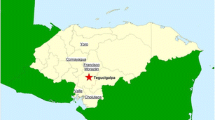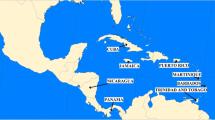Abstract
This investigation is the first nationwide survey on the circulation of leptospira infections in human beings in Italy. In nine out of twenty Italian regions, representative samples of the population were investigated for the presence of leptospira infections. Unexpectedly, leptospira infections were found to be widespread, the number of cases being much higher than the diagnosed clinical cases. There were found to be high, medium, and low risk areas. On the whole, the risk for the rural population was no higher than the risk for urban dwellers; leisure activities, contact with animals and residence on the plain versus residence in the hills were important risk factors. There was an unidentified risk factor in urbanites which was absent in the rural population. A changing pattern in infecting serovars was observed, with infections from serogroups Sejroe, Javanica and Australis prevailing over infections from the Icterohaemorrhagiae and Bataviae serogroups, which were the main agents of human leptospirosis during the 1950s. The mechanisms of these changes, the need for epidemiological surveys and improved diagnostic methods of screening are discussed.
Similar content being viewed by others
References
Cacciapuoti B, Nuti M, Pinto A. Human leptospirosis in Somalia: A serological survey. Trans Roy Soc Trop Med Hyg 1982; 76: 178–182.
Hanson LE. Immunology of bacterial diseases with special references to leptospirosis. JAVA 1977; 170: 991–994.
Waitkins SA. The epidemiology of leptospirosis in Great Britain. Communication at the 4th Meeting of European Leptospira Workers, Berlin, 12–14 October 1983.
Cacciapuoti B. Leptospiras as causative organisms of meningitis. Boll Ist Sieroter Milanese 1977; 56: 422–428.
Ciceroni L, Pinto A, Cacciapuoti B. Recent trends of human leptospirosis in Italy. Eur J Epidemiol 1988; 4: 49–54.
Cacciapuoti B, Vellucci A, Ciceroni L. Prevalence of leptospirosis in man: Pilot survey. Eur J Epidemiol 1987; 3: 137–142.
Coghlan JD, Norval J, Seiler HE. Canicola fever in man through contact with infected pigs. Br Med J 1957; 1: 257–261.
Cacciapuoti B, Ciceroni L, Calegari L, et al. A water-borne outbreak of leptospirosis. Am J Epidemiol 1987; 126: 535–545.
WHO Expert Committee on Health Statistics. Sampling methods in morbidity surveys and public health investigations, 10th report. Geneva, World Health Organization, Technical Report Series, No. 336, 1966.
Geigy JR, ed. Documenta Geigy: Tables scientifiques, 6th ed, 1963: 83–105.
Dikken H, Kmety E. Serological typing methods of leptospiras. In: Bergan T, Norris JR, eds, Methods in microbiology. London: Academic Press, 1978; 11: 259–308.
Babudieri B. Laboratory diagnosis of leptospirosis. Bull WHO 1961; 24: 45–58.
Galton MM. Methods in laboratory diagnosis of leptospirosis. Ann NY Acad Sci 1962; 98: 675–685.
Turner LH. Leptospirosis, II: Serology. Trans Roy Soc Trop Med Hyg 1968; 62: 880–899.
Ramadass P, Jarvis BDW, Corner RJ et al. Genetic characterization of phatogenicLeptospira species by DNA hybridization. Int J Syst Bacteriol 1992; 42: 215–219.
Yasuda PH, Steigerwalt AG, Sulzer KR et al. Deoxyribonucleic acid relatedness between serogroups and serovars in the family Leptospiraceae with proposals for seven newLeptospira species. Int J Syst Bacteriol 1987; 37: 405–415.
Babudieri B. List of leptospira strains kept in the WHO-FAO Leptospira reference laboratory in Rome. Ann Ist Super Sanità 1972; 8: 159–196.
Magnarelli LA, Anderson R, Johnson RC. Cross-reactivity in serologic tests for Lyme disease and other spirochetal infections. J Infect Dis 1987; 156: 183–188.
Istituto Centrale di Statistica. Annuario di Statistiche Sanitarie, Vols 23–33. Roma: ISTAT, 1976–1985.
Draper N, Smith H. Applied regression analysis, 2nd ed. New York: John Wiley & Sons, 1981.
Ellis WA, O'Brien JJ, Neill SD, et al. Bovine leptospirosis: Serological findings in aborting cows. Veterinary Record 1982; 110: 178–180.
Hart RJC, Gallagher J, Waitkins SA. An outbreak of leptospirosis in cattle and man. Br Med J 1984; 288: 1983–1984.
Shenberg E, Gerichter ChB, Lindenbaum I. Leptospirosis in man, Israel. Am J Epidemiol 1982; 115: 352–358.
Thiermann AB. Experimental leptospiral infections in pregnant cattle with organisms of the Hebdomadis serogroup. Am J Vet Res 1982; 43: 780–784.
Alston JM, Broom JC. Leptospirosis in man and animals. Edinburgh/London: Livingstone, 1958: 171–194.
Babudieri B. Epidemiology of leptospirosis in Italian ricefields. In: Advances in the control of zoonoses. WHO Monograph Series 1953; 19: 117–126.
Babudieri B. Les leptospires et la leptospirose en Italie. Soc Med Ital 1957; 5: 657–700.
Mino P. Ueber Leptospirosen bei den Arbeitern der Reisfelder Oberritaliens. Z Immunforsch 1939; 96: 466–485.
Borg-Petersen C. Experience of leptospirosis in Denmark. Proc R Soc Med 1949; 42: 714–723.
Salminen A. Studies on the occurrence of various leptospiral types in Finland. Ann Med Exp Fenn 1956; 34: suppl. 5.
Mino P. Zur Epidemiologie der Leptospirosen. Klin Z 1942; 21: 337–344.
Fuhner F. Über die Bedeutung der Mitreaktionen artverschiedener Leptospirenantigene bei der Auswertung serologischer Leptospiroseergebnisse für Klinik und Praxis. Z Immunforsch 1951; 108: 278–287.
Kmety E. Betrachtungen zum Problem der paradoxen Reaktion und deren Bedeutung in der Serodiagnostik einiger Leptospirosen. Zbl Bakt I Abt Orig 1957; 170: 597–609.
Cacciapuoti B. Co-antibodies in human leptospirosis. Boll Ist Sieroter Milanese 1976; 55: 495–509.
Birnbaum S, Shenberg E, Torten M. The influence of maternal antibodies on the epidemiology of leptospiral carrier state in mice. Am J Epidemiol 1972; 96: 313–317.
Ellis WA, Thiermann AB, Montgomery J Restriction endonuclease analysis ofLeptospira interrogans serovar hardjo isolates from cattle. Res Vet Sci 1988; 44: 375–379.
Author information
Authors and Affiliations
Rights and permissions
About this article
Cite this article
Cacciapuoti, B., Ciceroni, L., Pinto, A. et al. Survey on the prevalence of leptospira infections in the Italian population. Eur J Epidemiol 10, 173–180 (1994). https://doi.org/10.1007/BF01730367
Accepted:
Issue Date:
DOI: https://doi.org/10.1007/BF01730367




